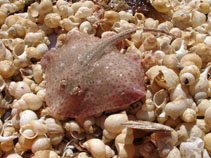| Family: |
Rajidae (Skates) |
| Max. size: |
120 cm TL (male/unsexed); 125 cm TL (female); max.weight: 14 kg |
| Environment: |
demersal; marine; depth range 10 - 380 m |
| Distribution: |
Eastern Atlantic: Shetland Islands to Morocco, Rio de Oro (Western Sahara), and Madeira. |
| Diagnosis: |
Dorsal spines (total): 0-0; Anal spines: 0-0; Anal soft rays: 0-0. Upper surface wholly prickly, except in juveniles; underside only prickly along front margins of disc; orbital thorns separate; a regular median row of 40-45 thorns in juveniles and adult females, interrupted on back in males; 60-90 tooth rows; upper surface ochre, with numerous small dark spots to margins of disc, underside white (Ref. 3167). |
| Biology: |
Found on sand and sand-rock bottoms (Ref. 6808). Feed on all kinds of benthic animals (Ref. 3167). Oviparous. Distinct pairing with embrace. Young may tend to follow large objects, such as their mother (Ref. 205). Eggs are oblong capsules with stiff pointed horns at the corners deposited in sandy or muddy flats (Ref. 205). Egg capsules are 10.0-14.3 cm long and 5.8-9.0 cm wide (Ref. 41250). About 40-90 eggs are laid per individual every year (Ref. 41250). |
| IUCN Red List Status: |
Near Threatened (NT); Date assessed: 01 December 2008 Ref. (130435)
|
| Threat to humans: |
harmless |
Source and more info: www.fishbase.org. For personal, classroom, and other internal use only. Not for publication.
